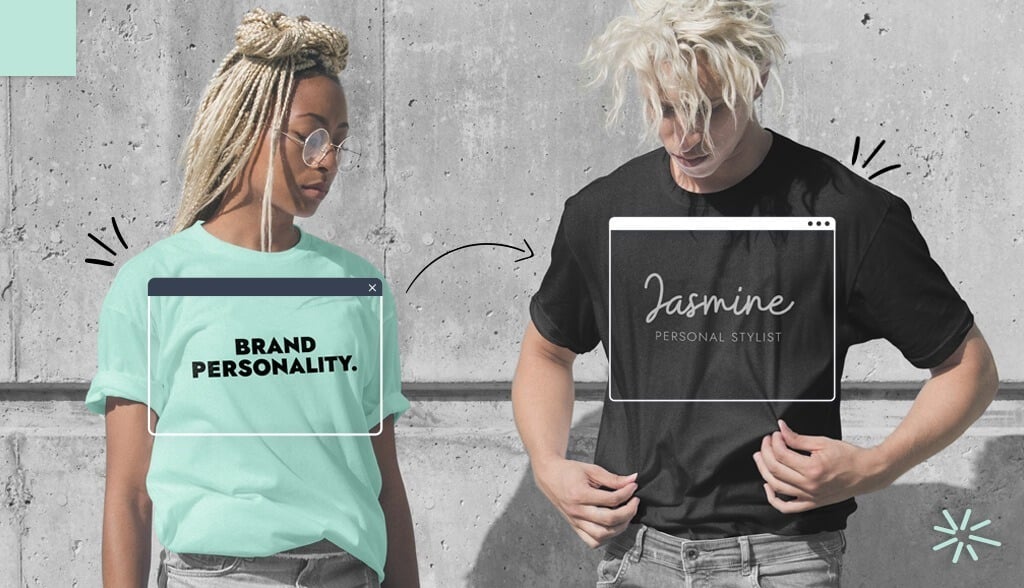
When starting a business, it can feel like you need to know an endless amount of things and be an expert in everything. The truth is you don’t. Who honestly knows everything about starting a business before actually…well, starting a business?
You may have heard about a brand personality before but didn’t pay much attention to it – and that’s okay. Whether you’ve heard of this term before or it’s your first time, in this post, you will learn everything you need to create your brand personality.
In short, a brand personality is what helps build a connection with your business. It’s why people stand outside of Apple for the new iPhone or why you only buy crackers from Trader Joe’s – this all happens because of brand personality.
Let’s be honest, you could shop at Costco, but you choose to shop at Trader Joe’s. Why? What’s so special about that store? While you may think it’s because you like their selection (which I can’t argue about), there’s more to it. It’s because you like the personality of Trader Joe’s.
It’s why people buy their shoes at Adidas or their clothing from Zara. Each business gives off specific characteristics we connect to. For example, Zara is beautiful, stylish, and fashionable. Adidas is stylish, authentic, cool, and health conscious. Trader Joe’s is savvy, earthy, and fun-loving.
Your brand personality humanizes your brand. It’s a set of personality traits that define your business. Think of it as creating a character. A brand personality creates a character for a business that they can use to connect with their customers.
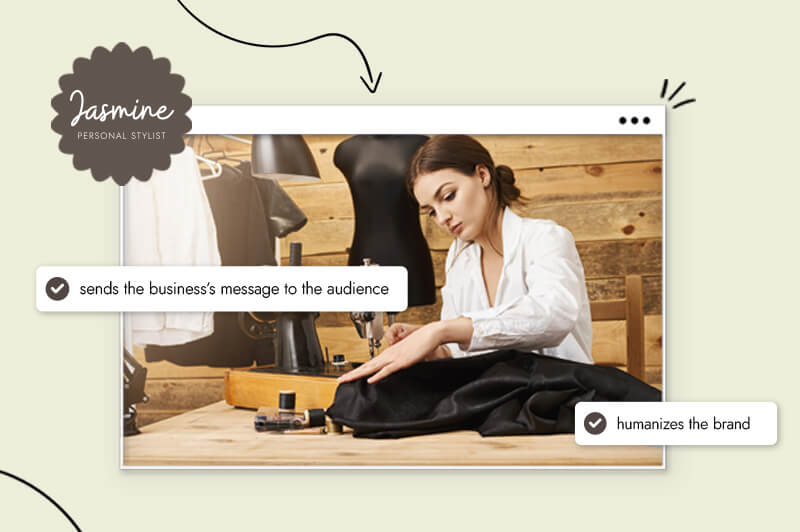
I talked about what brand personality is, but do you really need one? While I’m not trying to put more things on your to-do list, I wouldn’t be talking about this if it wasn’t important for your business. Building a brand personality can:
Many businesses underestimate the power of brand personality, but by doing so, they fail to connect with their customers. A brand personality mirrors the traits customers value. As a result, this builds an emotional connection to your audience. It helps the customer decide which business they’re going to purchase from.
You want to build a brand personality that shows your business’s values, culture, and personality. How can you do that? By understanding the different dimensions of a business’s personality.
The best way to learn about a brand personality is to use Aaker’s 5-dimensional model. The categories below will show you the different personality dimensions a business can have. Usually, businesses will focus on 1-2 personality dimensions, while balancing the others.
Businesses with a competence personality dimension are shown as:
Businesses that build themselves around a competent personality see themselves as intelligent, reliable, and hard-working. They focus on producing high-quality products/services.
Businesses like Volvo, which prides itself on its “years of leadership in automotive safety,” have a competent brand personality. They want you to know that you can trust them.
Brand example: Rolex
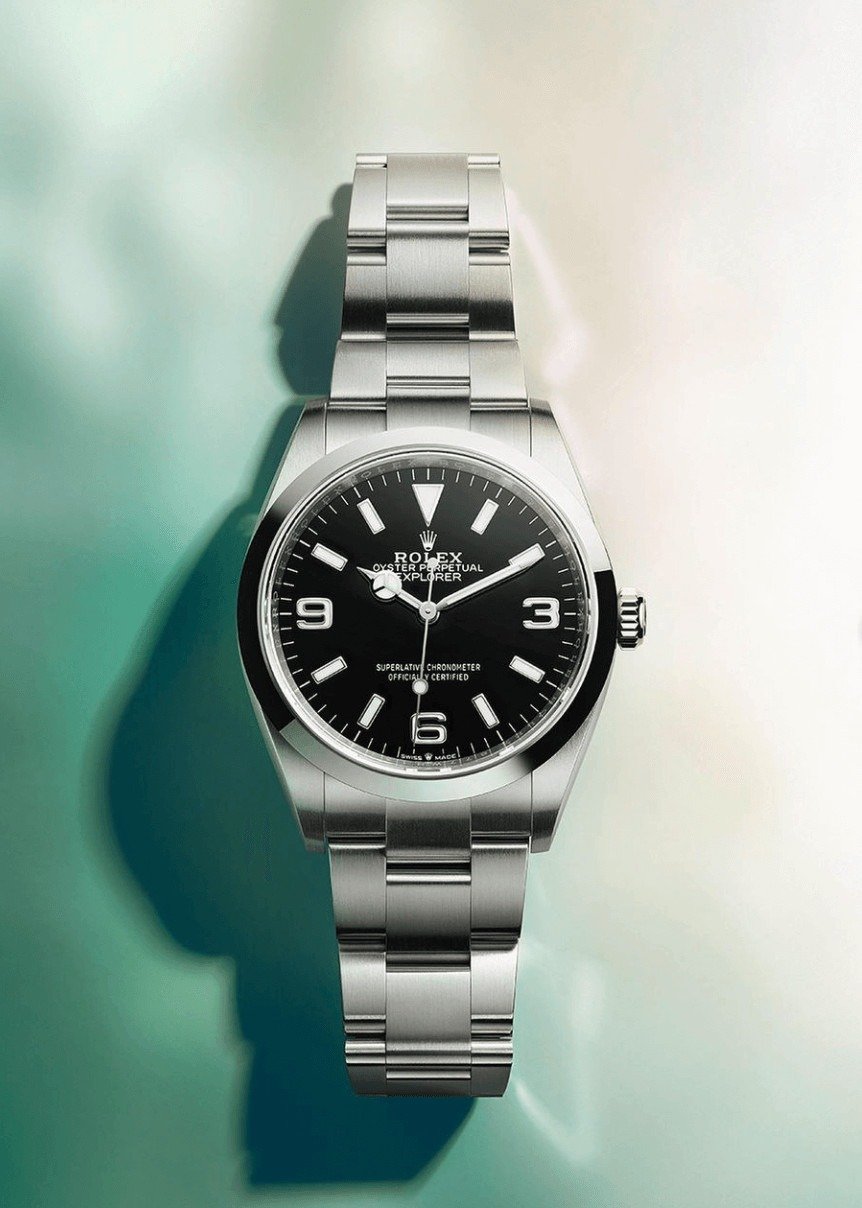
We all know Rolex. Whether we can all afford a Rolex is a different story, but when you think of Rolex, what comes to mind? They’re known for producing the world’s finest watches.
Their watches are reliable, smartly designed, and they have a successful product. This resonates with their audience, it’s why so many people dream of having a Rolex on their wrist. Rolex symbolizes power and success.
Takeaway: To help convey your brand personality, choose a logo that represents your personality and values. Rolex’s logo symbolizes power and prestige. The bold font, alongside the green and gold color combination, further supports their brand personality.
Businesses with a rugged personality dimension are seen as:
Rugged businesses have an outdoorsy and tough appeal. The brand colors are typically darker (gray, black, navy blue, and army green), and their fonts are thick with less detail. Through this, businesses convey that their product is durable, tough, and designed for customers who are outdoorsy and like to take risks.
Brand example: Jeep

For over 80 years, Jeep has associated itself with freedom, toughness, and adventure. Jeep believes their customers can go anywhere and do anything with their product. Their vehicles haven’t changed much throughout the years, yet they have a strong customer base that keeps coming back for more.
Takeaway: Building a strong brand personality not only will help you connect with customers, but will create returning customers. Deeply connecting with your customers on an emotional level will keep them coming back.
Businesses with a sophisticated personality dimension are depicted as:
Sophisticated businesses are ones that are perceived by consumers as luxury, glamorous, and high-end. And we usually see these types of businesses in luxury industries (with the price tag to match).
You’re probably thinking of high-end fashion and accessory businesses, but the sophisticated personality isn’t limited to any industry. It can fit in any industry, whether it’s food, cars, pet food, or carpets – they’re everywhere.
To show sophistication, businesses usually choose thin fonts, simple designs, and soft colors. Luxury logos play a significant role in helping show a sophisticated brand personality.
Brand example: Louis Vuitton
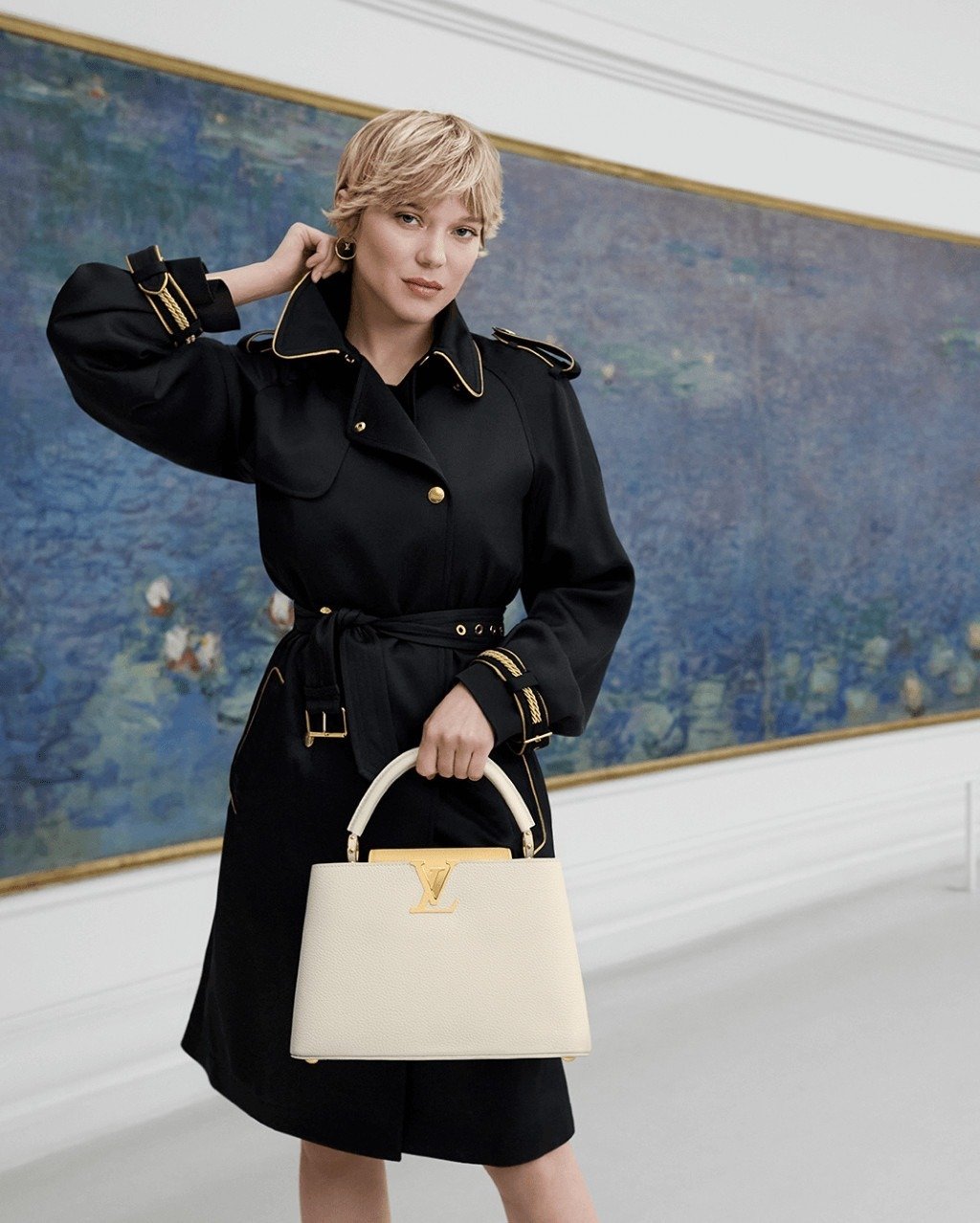
Louis Vuitton is a high-end fashion and accessory brand founded in 1854 by (take a wild guess) Louis Vuitton. The LV logo was easy to spot and quickly became a status of wealth and power. But what makes Louis Vuitton sophisticated?
The answer is that they positioned themselves that way. Louis Vuitton charges high prices for their products, they use celebrities and international models for their marketing campaigns, and only offer their products in high-end stores. And mix all these factors together and it’s a sophisticated business.
Takeaway: A brand personality is based on what consumers think of your business. If you want consumers to see your business in a specific way, you need your business to act the part.
This goes beyond visuals. Acting the part includes communicating in a way that’s consistent with the persona you’re trying to create. Vuitton knew what he wanted his business to become and focused on developing the specific image he desired. He stuck to his brand personality and created a foundation for his business to grow on.
Businesses with an exciting personality dimension are presented as:
This dimension connects with businesses that want to be seen as daring, inspiring, and trendy. You already know some businesses that fall under this category. These businesses tend to use bright and engaging logos, ads, and imagery and show themselves in exciting and edgy places. Did Nike or Red Bull come to mind? These are popular examples of the excitement dimension and you can see why.
Nike inspires and celebrates people who live their lives to the fullest – their slogan “just do it” is daring and exciting. Red Bull is a business built around pushing the boundaries and using your imagination to do bold things. But you don’t need to have a sports business to fall under this category.
Brand example: Faye Travel

Faye Travel is a travel insurance company. I know, yawn. What’s exciting about travel insurance? Nothing. Well, that was before Faye Travel. They took travel insurance and flipped it over into an exciting product for customers, by using a bright and playful color palette, bold font, and inspiring images. Their website is youthful, inspiring, and exciting–bringing new energy into the insurance world.
Takeaway: Step outside of the box when forming your brand personality. You don’t need to have a specific business to create an exciting brand personality. Faye Travel uses their brand personality to turn something boring–insurance–into something that connects to their audience and encourages them to take action.
Businesses with a sincere personality dimension are portrayed as:
Sincere businesses are typically viewed this way because they tend to follow their commitment to community or other consumer issues, like sustainability or economic equality. These businesses are usually transparent with their intentions and policies and focus on building strong customer and employee relationships.
You won’t tend to see sincere businesses in any scandals, since they focus on transparency with their employees and customers.
Brand example: Patagonia

Patagonia is an American outdoor clothing and sporting gear store founded in 1973 by Yvon Chouinard. Yvon was a sports enthusiast, but also an environmentalist who focused on global issues. Since its founding, Patagonia has helped spread environmental awareness through programs such as “Worn wear.”
The program allows customers to sell back Patagonia clothes. Patagonia will then repair and re-sell the clothing online. Today, Patagonia is one of the world’s leading environmentally-friendly and sustainable clothing businesses. Their brand personality is clear and has helped build a loyal customer base who share the same values.
Takeaway: Choose values that resonate with your business. Do not pick values that you feel are trending – they need to mean something to you. The values you choose will define your business and build your business in the long term.
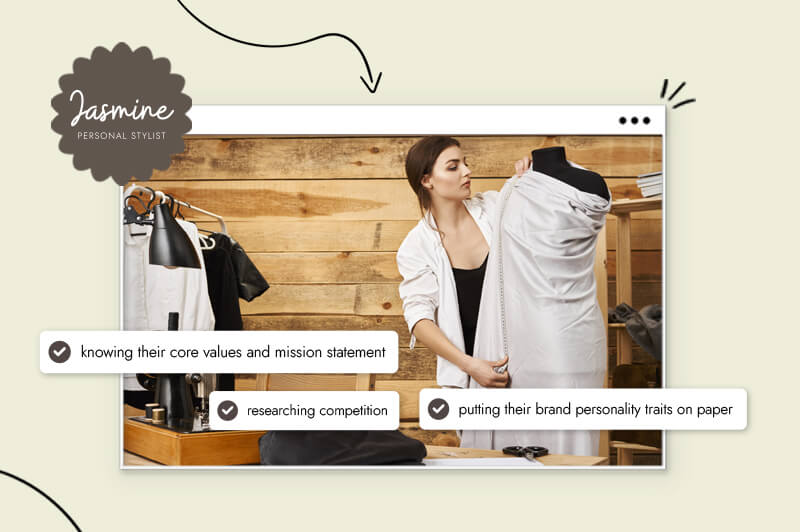
You know what the brand personality types are. Read them again and see which one(s) connect with your business. If you’re not sure yet, don’t worry. You’ll get there, you don’t need to rush. Follow these 6 steps to help you create your own brand personality.
It’s important to focus on your customers, but how can you connect with them if you don’t know what your business represents? Values are important; values shape who we are. And the same goes for your business.
You’ll want to start by outlining your core values. What’s important to your business? Once you have them written down, you’ll want to write them out in a mission statement. Your mission statement states the purpose of your business and how you will serve your customers. Your mission statement will be the foundation of your brand’s personality.
For example, here are some mission statements from businesses you know:
Patagonia: “We’re in business to save our home planet.”
Patagonia’s mission statement is clear. They value the environment. But how will a clothing apparel and sporting gear store do that? Well, they have a clothing recycling program, follow sustainable practices, and pledge 1% of sales to environmental preservation and restoration.
IKEA:“To create a better everyday life for the many people”
We’ve all bought something from IKEA. But how does their mission statement match their business practices? IKEA not only produces affordable furnishings, but they also focus on using sustainably sourced materials.
The Honest Company: “To empower people to live healthy, happy lives.”
The Honest Company is focused on producing safe and trusted products for their customers. Their formulas are made in-house and are held against a high standard of safety and transparency.
As you can see, the mission statements given by these businesses are followed through by their business practices. A mission statement acts as a guide and will help you make business decisions that align with your brand personality.
How can you write a mission statement? Your mission statement can be short or long, but the point is to write the purpose of your business. For a mission statement, you need to include:
Once you outline your core values and mission statement, you can move on to step 2.
You don’t need to copy your competition – that’s not what I’m talking about. Actually, I’m going to tell you the opposite. You want to stand out from the competition, but to do that, you need to know what your competitors are doing.
If all your competitors are following the same brand personality, maybe you’ll want to take another path and focus on a different brand dimension. If you’re new to competitor research or need a refresher, don’t worry, I got you covered. Read this post to learn how to do competitor research.
When doing competitor research, there are a few things you want to look for:
By researching your competitors, you can find out what they’re offering and not offering their audience. From there, you can see how your business can fill in the gaps and give customers what they need.
Your ideal audience is who your business should represent. If you have a luxury watch business, your brand personality won’t be the same as a men’s sporting gear business. These 2 businesses are speaking to different audiences. While you should establish your business’s core values, you then need to look at who your audience is.
So, to do that, you’ll need to conduct audience research. You’ll be asking questions like:
The more you understand your audience, the easier it’ll be for you to build your brand personality. Your brand personality is a mirror of your audience or who they want to be.
If you haven’t done audience research before, don’t worry. It’s not as scary as it sounds, but it will take some time. To learn how to conduct audience research, read this post for a step-by-step guide.
It’s time to put your brand personality traits on paper. By now, you probably have some idea of which personality dimension your business falls under.
Write down the adjectives you think best describe your business’s personality on a piece of paper and pick 3-5 traits from your list. Once you have your selected list of traits, you can see where your business fits – is your business sophisticated, rugged, competent, exciting, or sincere?
Now you have everything you need to turn your brand personality into a human. Remember, a brand personality essentially creates a character of your business. To get started, do the following:
Write a few sentences about your brand personality as if it was a person. Describe what they like, dislike, and even how they look. Here’s an example of this:
“Sarah loves the outdoors, she’s not the type of girl who will spend her weekend watching tv. She’s an athletic girl but would rather go on hikes than hit the gym. She’s not a fan of fast food but will take a fresh salad any day. During the week, she’s going to school for environmentalism and hopes to create her own foundation for animal conservation.”
Also, think about how you will speak to your customers. The jokes, slang, and general language you use will shape your brand personality. Think about how you will communicate with your audience.
Now that you know the elements of your brand personality, you can start to create a brand style guide. A brand style guide is a document that outlines your logo, fonts, color palette, types of imagery, and brand voice (the way you talk to your customers). In addition, your brand style guide will also include what your brand isn’t.
For example, let’s talk about logos. Your logo should reflect your brand personality. The following are colors that suit each dimension:
Knowing which colors suit your brand personality can help you design a logo that will connect with your audience.
Your brand style guide will give you a standard for how you’ll design and convey your brand on your website, social media platforms, and with marketing. To learn more about creating a brand style guide, read this.
Mention how you may need to change it down the line – but only if you see something isn’t working, like that your audience isn’t connecting, you’re getting a lot of bad feedback on social media, reviews, etc.
Once you’ve completed all the above steps, there’s one thing you need to remember: You need to stay consistent. What does this mean? This means whatever brand personality you choose, you stick to it. If not, your business will not have a distinct voice and you’ll struggle to connect with your audience.
Additionally, staying consistent also includes your font, color palette, and imagery. Consistency will help create recognition for your business, which is especially important for new businesses.
However, you may need to change it down the line if you’re seeing something isn’t working. If your audience is connecting or you’re getting a lot of bad feedback on social media or reviews, you may need to tweak some things.
Creating a brand personality isn’t something you do with the snap of a finger – and it shouldn’t be! You’re developing the foundation of your business, and the characteristics that your customers will connect with. So, take your time. Follow the steps above to create your brand personality. Once completed, you can move on to create your logo and website.
This portion of our website is for informational or educational purposes only. Tailor Brands is not a law firm, and the information on this website does not constitute legal advice. All statements, opinions, recommendations, and conclusions are solely the expression of the author and provided on an as-is basis. Accordingly, Tailor Brands is not responsible for the information and/or its accuracy or completeness. It also does not indicate any affiliation between Tailor Brands and any other brands, services or logos on this page.
Products
Resources
©2025 Copyright Tailor Brands